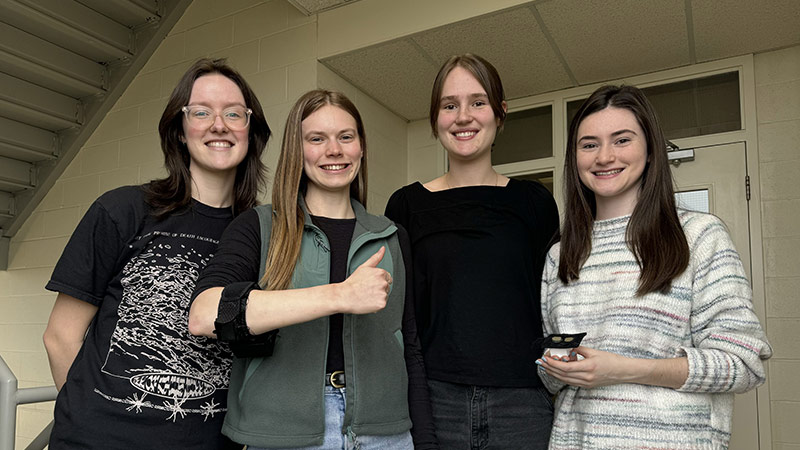Force myography may be the future of human-machine interaction
Author: Tim Jaques
Posted on Mar 28, 2024
Category: Research , UNB Fredericton

A device under development at the University of New Brunswick’s (UNB) Fredericton campus that captures the movements of a user’s arm muscles may be a breakthrough technology poised to reshape the landscape of human-machine interaction.
“We are using the patterns of muscle forces exerted on the cuff to recognize what gesture a person is eliciting,” said Erik Scheme, associate professor in the department of electrical and computer engineering at UNB’s faculty of engineering, and associate director of the Institute of Biomedical Engineering (IBME) located on the UNB Fredericton campus.
Mechanical engineering students Julia MacPherson and Leah Morrison, partnering with electrical engineering students Sarah Boyd and Robyn Meredith, all in their fifth year, are developing a device to do this as their final year capstone project.
Through the IBME, Scheme is the project’s sponsor.
This innovative wearable technology will be one of the projects presented at the 10th annual Engineering Design Symposium to be held April 4 from 8:30 a.m. to 4:30 p.m. at the UNB Wu Conference Centre in Fredericton.
“What we are trying to do is recognize the subtle gestures a person makes, and then we can harness that to control a prosthesis, an exoskeleton, a wheelchair, or any other smart home device or cursor on a screen,” Scheme said.
When fully developed it could translate muscle pressure patterns into data for applications spanning assistive technology, smart home automation, and digital interfaces, and generally enhancing accessibility and convenience.
While electromyography relies on the electrical signals generated by muscles, force myography uses sensors - in this case six, with an option to add two more - placed around the arm at separate locations to capture the limb deformation and the pressure of the muscles pushing against the outside.
“If you are trying to open or close your hand, or rotate your wrist, or squeeze your fingers, all those different muscle contractions cause different patterns of forces to happen at the surface of the forearm,” he said.
The signals are transferred to a computer via Bluetooth, and the pressure measurements are used to determine a pattern via machine learning to recognize the gestures the wearer is making.
There is currently no commercial product using force myography that does this.
“The IBME here at UNB has been a global leader in prosthetic control for decades. We’re Canada’s first Institute of Biomedical Engineering and we were among the first to commercialize muscle-based prosthesis control,” Scheme said.
“We’ve done human-machine interaction with electromyography for a long time, but force myography is still very much in the research space. Our research has shown that it’s feasible, but nobody’s really developed a commercially viable product yet that can be worn and used for this kind of thing,” he said.
The challenge for the students is to develop a cuff that is flexible enough for use by different people and that can be put on the arm quickly and comfortably. It must be robust, and able to provide data that can quickly be interpreted by machine learning models so users can interact with it.
“The mandate is to develop the device so that we can continue to use it, and further the research, and then create a better case for it as a potential commercial product,” he said.
Each of the students will speak at the group presentation at the symposium.
“Experiential learning is critical for engineering students’ overall education at UNB,” said MacPherson.
“This project has made us all better at independent learning, problem-solving and design implementation, all of which are helpful for careers in engineering,” she said.
Boyd said the four had “learned a lot” while participating in the project.
“By going from the idea stage through to implementation, we have combined years of classroom learning into hands-on design and prototyping,” she said.
Meredith hoped their project could be built on by future students.
“We hope that our device can be used for force myography research at the IBME and provide opportunities for other engineering students in the coming years,” she said.
Morrison said this kind of technical project requires “strong teamwork and communication” between group members.
“Supporting each other and collaborating on problems has been integral to our project’s success,” Morrison said.
While the students are the project developers, Scheme gave them guidance and design requirements.
“They take those design requirements and turn them into what it is. They’ve proposed the design of the device, they’ve proposed the electronics, the communication. It’s a challenging project for them, because not only do they have to do the sensor design and the hardware design, the mechanical components, the electrical components, but they also have to understand the interaction side of it,” he said.
“The requirement was the ‘deliverable’ of a cuff that captures those signals wirelessly and communicates them across to a computer. Once you get that signal from the cuff, what you do with it is arguably a bit easier than getting that signal in the first place.”
Troy Lavigne is a project officer in the department of electrical and computer engineering and is a co-instructor of the ENGG4000 Electrical Design section.
“I’m extremely pleased that this talented group of UNB undergraduate electrical and mechanical engineering students, who are our future engineers, are tackling such a challenging and worthwhile project as the Force Myography Wearable, sponsored by Dr. Erik Scheme and IBME,” he said.
“Julia, Leah, Robyn, and Sarah have demonstrated engineering knowledge and skills desired both within academia and industry, and I’m positive that they have long and successful careers in their future.”
Banner photo: Fifth-year engineering students (from left): Leah Morrison, Sarah Boyd, Robyn Meredith and Julia MacPherson.
